Welcome! My name is Eugenijus and I'm a BA Film Graduate from Middlesex University. On this blog you will find work I did during my time in education and beyond.
Don't wanna be here? Send us removal request.
Video
youtube
A short segment I shot/edited to be used as a projection in a museum.
0 notes
Video
youtube
A promotional ad I shot and edited for a company that makes holographic commercials.
0 notes
Video
youtube
Life couldn't get much worse for insurance salesman Fergus Baker. But when the stranger he cold calls one morning offers to pay off his debts in exchange for completing three tasks, Fergus must decide if he is willing to take the biggest gamble of his life.
0 notes
Video
youtube
Donald, a retired man struggling to cope with the recent death of his wife, becomes increasingly frightened as he starts seeing her favorite flower everywhere he goes. After battling with his hallucinations throughout the day he finally regains his sound mind by learning to cherish the time spent together with his wife and appreciate the time he has left.
0 notes
Text
Hologram showcase
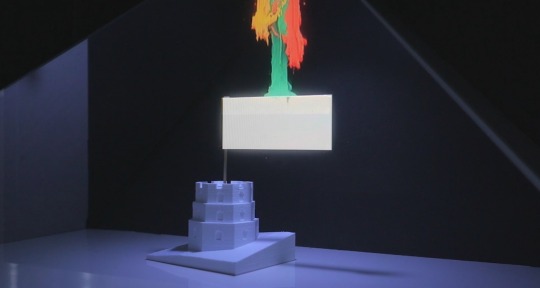
I was employed to shoot a short commercial from a company that makes holographic ads for various companies. The particular one I was doing was their own intro. At first I was worried of getting good footage due to the fact the hologram was going to be shown behind a glass panel, so the use of lights would make things difficult due to reflections. However, after waiting for it to get dark and the hologram itself being rather bright I managed to get all the footage from multiple angles and using a slider. As the hologram was going in a loop I simply had to edit it from the various angles in a sequential order to get what I needed.

0 notes
Text
Horse tracking shot
So I was employed to shoot a horse dragging a plough for a certain museum where they the footage would be projected unto a wall, along with an effect that would simulate very old footage.
For the shoot I was required to use a DJI Ronin stabilizer for the first time. At the beginning I found it very difficult to behave the way I wanted but we managed to get a good enough shot even though I feel I still didn’t quite get the hang of it. It was also very helpful for my co-worker to guide me by hand through the muddy terrain.

To make the footage to look old was just a matter of searching online for the various filters I would need to use to get the desired effect. After a bit of doodling I finally managed to achieve it.

0 notes
Text
Editing museum guides
So in between shooting all the museum guides I had the job of editing the footage. Initially I thought that it would be very easy as I thought the only think I would need to do was to key out the greenscreen. However, the farther we edited and sent the footage to the museums we realized that we were too forgiving for certain mistakes the actors made while reading the lines, whether it be pronunciations or other mistakes. As a result we were forced to reshoot several of the museums multiple times until we had a satisfactory result.
While editing indeed was mostly about removing the background, there were several moments where I had to engage in audio editing. Seeing as we couldn’t always afford to reshoot with and actor again or couldn’t bother due to the minority of the problem, I had to cut in certain words from other clips and replace them in the problematic files. At times it was a very stressful process, as it was difficult to stick the words in a way that would be smooth but at the end the result seemed to be satisfactory.

Another issue we encountered was where we had the actors pause in between paragraphs for a little break, we had to cut out several sections of footage to eliminate those pauses for a continuous video. Sometimes it would be difficult as the actors shifted in their positions but once we had them stand totally still during these segments, the issue was resolved.
0 notes
Text
Museum guide shoots
So I managed to secure a project in Vilnius where I would have to shoot actors against a greenscreen that would act as guides on 26 Lithuanian museums in both English and Lithuanian. It was my first time shooting with greenscreen so understandably I was quite intimidated by the prospect. However, after doing my research I managed to pull off a an evenly lit background and from then on I was more comfortable with the project. Luckily I was provided with a set of radio microphones so audio did not become and issue, apart from the occasional static.
I also had the chance for the first time shoot from behind a teleprompter, which turned out to be somewhat challenging as it was difficult to find ways to attach the camera in a stable way to it. Luckily the building in which we were working had an engineering department so they provided us with certain instruments to do so.
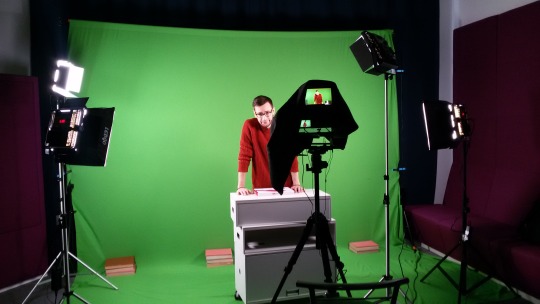
After a few problems in the beginning as me and my co-worker were figuring out a good workflow with the actors we managed to figure out a good process to work by.
With the background working and the sound good we proceeded to shoot for a year and a half. Twenty six museums in total. It mostly was down to the actors to deliver the lines well.
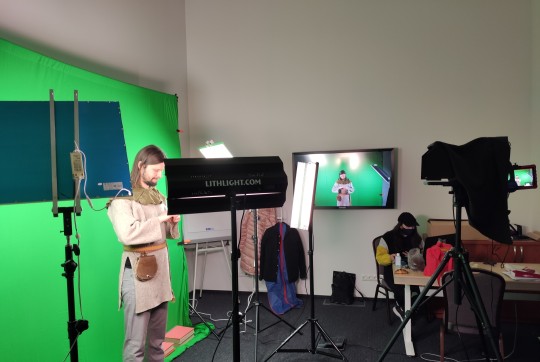
0 notes
Text
Mineral water commercial shoot
So a few months ago I was invited by my friend Elvina so participate as an assistant on her shoot for two of massive Lithuanian mineral water companies “Ausra” and “Vytautas”. It was a rather interesting project as unlike many other commercials it would involve many elements that are more akin to documentaries, such as interviews and coverage of the entire process of making one of these products, ranging from manufacturing of he bottles to experiments in the lab to determine the quality of the water.
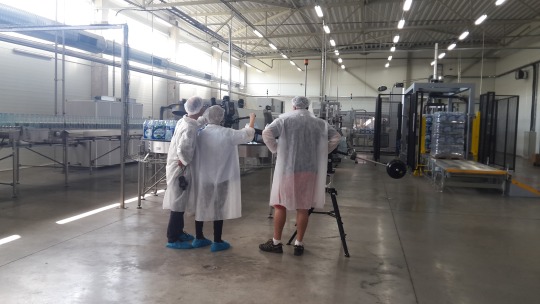
There were a total of four of us on the project as a whole. With Elvina functioning as the director, my old university lecturer David Heinemann and a professionally hired grip, who brought along a truckload of equipment. I was usually functioning either as runner or as someone to assist the camera movement. Mostly, I was helping the grip assemble the dolly tracks or the jib, something that I didn’t get a chance to do on Elvina’s previous project, so in addition it was somewhat of a learning experience as well.
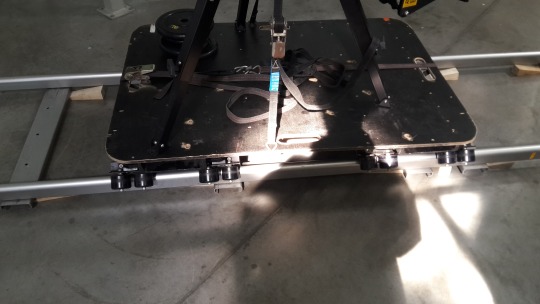
0 notes
Text
MDA3200 Research Essay: ‘A historical perspective on auteur theory’
Even though film has been distinguished as an art form since the 1920s the debate whether there can be an assigned author to the work produced wouldn‘t be brought up some 30 years later by a group of French film enthusiasts, later to become the leading figures of the French New Wave movement. Spurred by the distinguished styles of both American and French directors, as well as Alexandre Astruc‘s concept of camera-stylo, the idea that a film director should use the camera as a writer of literature would use a pen, they championed the director‘s role within a production as integral to the eventual outcome, disregarding the studio films coming out in France as lacking originality. Holding up such directors as Alfred Hitchcock and Jean Renoir as examples of true auteurs of their craft, the argued that despite the collaborative nature of filmmaking, a truly „good“ director‘s personal style and vision will shine through the conglomerate of all the creative talents involved, creating a pattern of general themes or techniques throughout their body of work and solidifying their „authorship“ of the product. Understandably, there has been much debate over the validity of this theory as a proper method for analyzing film, calling it a romantic notion proclaiming the importance of the director yet at the same time disregarding the input of the other major creative figures of the film, such as the cinematographer or writer. In this essay I will attempt to take an objective look at auteurism through its evolution in film theory debates, from its inception to its harsh critizisms, using examples of filmmakers and their methods throughout history, and try to come to a conclusion to its validity.
A certain tendency towards authorship within film can be traced to its earliest days when D.W. Griffith first experimented with film as an expressive language in revolutionary work such as
Birth of a Nation (1915)
. Ushering in the era of the feature film, this controversial motion picture, revolutionized narrative, in the ways that story can be told and emotion expressed. Effectively transforming cinema from a novelty into an artform. Most films made by Griffith since have had his name plastered across posters, reinforcing the idea that due to this particular individual‘s reputation as a master of a craft, who‘s sheer influence in the many aspects of a production is so extensive, that the quality of the finished film, is directly credited to the filmmaker, and can be used in its marketing as a stamp of quality. Though the names of the cast might become more prominent in the advertisement of the picture, the filmmaker‘s name continues to appear, as evident in the careers of such filmmakers as Howard Hawks and Jean Renoir.
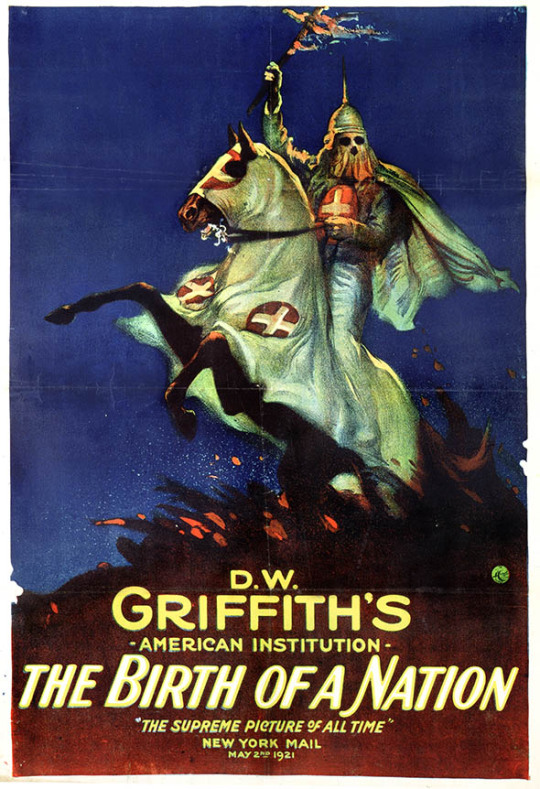
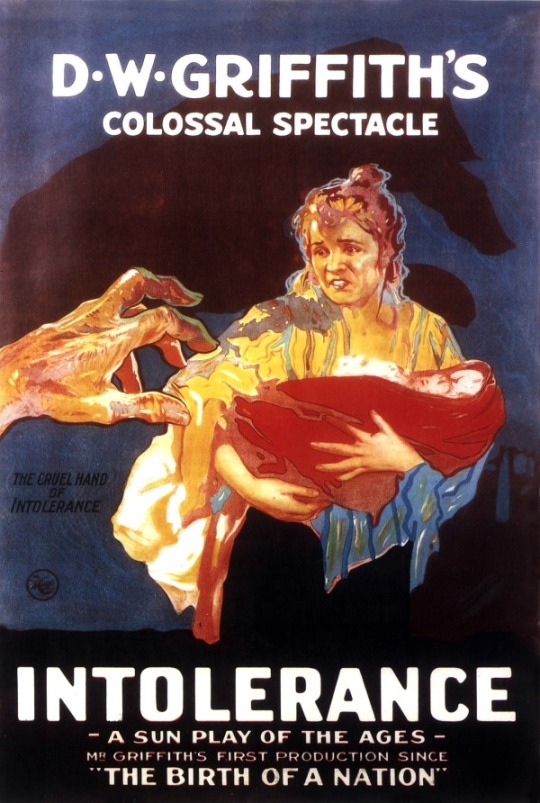
Therefore, it is understandable why Francois Truffaut would attempt to reinforce the idea that „there are no good or bad movies, only good and bad directors,“[1] meaning that a good director can bring a bad story a sense of quality through his interpretation of the material. In his provocative essay „A certain tendency in French Cinema“, Truffaut criticized the French Cinema‘s reliance on literary classics, citing that the director only works as a „stager“[2], in effect working only as an interpreter of a world created by the screenwriter, inhibiting innovation and constricting film criticism to particular values. This harsh criticism of the films of the time can be mostly attributed to the influx of American Cinema, after the liberation of France, during World War II[3]. Having been isolated from any foreign content during the nazi occupation, the new and exciting films from across the Atlantic dazzled the cinephiles of France. Truffaut in particular, showed an appreciation for directors‘ who‘s films showed a distinctive style or a particular theme that runs across their body of work, in particular, he pointed to the works of Alfred Hitchcock as stamps of auteurism. Because of the level of control that Hitchcock was able to exert on his films, from conception to post-production, he was able to bypass the constraints of studio systems and bring forth very distinct, highly personal motion pictures for mass audience consumption[4]. However, auteur theory wasn‘t taken seriously until Andrew Sarris‘s „Notes on the Auteur Theory“, where, even though he provides criticism to Truffaut‘s theories of film having a singular author yet puts it forth as a model for analyzing film, outlining particular aspects that have to be present through his work, for him to qualify as an auteur. Starting with technique, to personal style and interior meaning being the most important in order give film a distinct voice, this model can be effectively applied to the career of Hitchcock, particularly in regards to his production of Vertigo (1958). The famous dolly-zoom or „vertigo“ effect has been popularized by Hitchcock[5], becoming his signature camera movement, along with the innovative editing techniques seen in Psycho (1960), Hitchcock has secured his status as technically competent director. However, maybe most evident is the way that Hitchcock expresses himself stylistically by making use of the mise-en-scene. Throughout Vertigo we see Kim Novak‘s character always surrounded by the colour green, signifying the object of the protagonist‘s desire. This choice goes further as we see the same emerald colour appear through various scenes of the film, as the characters spirals further into obsession. Hitchcock even gave special significance to the clothing that characters should wear, instructing his production designer to create Madelaine‘s dress in a way so that she would be psychologically jarring. All of these decisions serve to better convey the interior meaning and the director‘s own personal concerns, most of which fall into the study of psychoanalysis[6]. A similar pattern can be seen in the works of other filmmakers that were capable of exerting such a level of control and involvement over their productions, such as Stanley Kubrick. Himself being extremely competent in nearly all production aspects, Kubrick himself pushed the envelope of cinematic techniques, with the famous stargate sequence in 2001: A Space Odyssey (1968) and the candlelit scenes in Barry Lyndon (1975). However, his methods of staging a scene coincided with those of an auteur, providing room for collaboration, if he felt that the script didn‘t work, in this way pushing back the importance of the script and the writer.[7] Although Kubrick is known to finish his films with open endings, allowing the audience to draw their own conclusion, however the general themes of dehumanization, control and authority, run through his entire body of work. So in this sense, the careers of these filmmakers confirm the validity of auteur theory, as their particular methodologies give their pictures a quality, which solidifies their authorship over the work. However, while examples of certain filmmakers seem to prove the theory, there is an equal amount of arguments contradicting it, as is evident of the wave of criticism that followed it in the 1960s.
Auteur theory has been under scrutiny from its very beginning, even by Andre Bazin[8], the person who proposed its significance to the film in the first place, pointed out the way it disregards the input of all the other individuals involved. While released as a piece of literary criticism, Roland Barthes‘ text ‚The Death of the Author‘(1968), assigned importance to the interpreter rather than to the text or the author, arguing that it is the audience that gives a work meaning, as they are the ones that ultimately engage the material, making his work applicable to film authorship as well[9]. Yet the harshest wave of criticism of auteur theory came with Pauline Kael‘s review of Citizen Kane (1941) in 1971. Using this film that typically serves as a model for auteur theory, Kael argues against its validity, pointing out Orson Welles‘ use of the distinct talents of the cinematographer, the screenwriter and the collaborative nature of film in general[10]. Indeed, several critics downright condemned auteur theory as something „would not be worth bothering with if it hadn’t…effectively [stalled] film history and criticism in a prolonged state of adolescent romanticism[11]“, claiming that filmmaking has too many variables to assign credit to just one individual. Coming back to the authorship issue in the proto-years of cinema, while many of Griffith‘s work was advertised with his name in the forefront, however across the Atlantic, another filmmaker - Sergei Eisenstein - was making equally important motion pictures yet his name is almost completely absent from the advertisements in the Soviet Union. This obviously is partly due to the political agenda of Russia‘s ruling power at the time, which promoted the efforts of the collective rather than the individual, yet this can also be the result of Western Culture‘s emphasis on the importance of the creative force, as pointed out in Barthes‘ text, rather than the viewer. Regardless, Eisenstein‘s name is as influencial today as that of Griffith‘s, this can be attributed to the unquestionable influences both of them had on cinematic language, however if we look at more recent examples of filmmakers, the question of who should be credited for innovations in certain techniques[12].
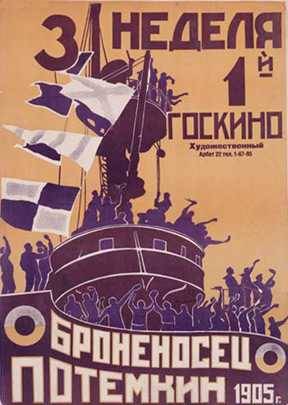
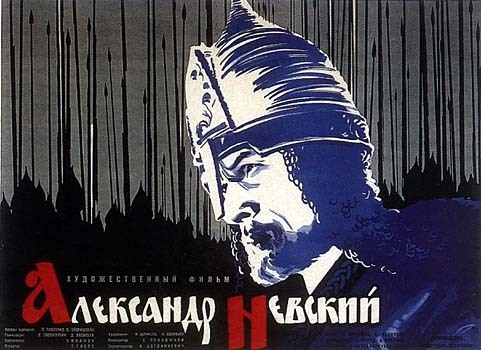
Looking back at the career of Hitchcock and his signature „dolly-zoom“ effect, people naturally associate this with his name regardless of the development and the people involved. While it is undisputable that Hitchcock is the first one to popularize this technique, cameraman Irmin Roberts is the one credited for first successfully putting it to use. Even more so, the dolly-zoom as an effect was conceptualized by a Romanian cinematographer Sergiu Huzum beforehand[1]. Which begs the question – who truly is responsible for this innovation? If Hitchcock has conceived, physically performed and popularized the movement himself, his technical aspect of authorship would be undeniable, however since the dolly-zoom went through several hands before it seemingly landed into Hitchcock‘s lap. The fairness and generalizing nature of autership becomes apparent.
While the influences of auteur theory cannot be denied in terms of how we perceive and analyze cinema today, indeed even in the works of contemporary filmmakers who retain a distinct style, such as David Fincher or Quentin Tarantino. Auteurism is evident as these motion pictures are often advertised with the director‘s name in the forefront. However, delving deeper into the intricacies of filmmaking, it becomes evident just how, unlike any other, it's impossible to assign credit for the whole process to a singular individual. While the role of the director as the driving force for the creative desitions of a production is undeniable, it is extremely unfair to assign authorship of a thing which requires the collaboration of dozens if now hundreds of people to a single individual. Then again, because of the way auteur theory prompts audiences and critics to dissect the intricacies of the filmmaking, it can also serve to inform the methodologies of other filmmakers. After all, whenever a filmmaker cites influences on his work, for better or for worse, it is the director‘s name that he puts forward.
References:
Bibliography:
· Truffaut, Francois. "A Certain Tendency Of French Cinema (Une Certaine Tendance Of Cinema Francaise)". Newwavefilm.com. N.p., 2016. Web. 29 Apr. 2016.
· Thompson, Kristin; Bordwell, David (2010). Film History: An Introduction (3rd ed.). New York: McGraw-Hill. p. 382
· Etherington-Wright, Christine and Ruth Doughty. Understanding Film Theory. Houndmills, Basingstoke, Hampshire: Palgrave Macmillan, 2011. Print.
· Webster, P. (2010) Love and death in Kubrick: A critical study of the films from ‘Lolita’ through ‘eyes wide shut’. United States: McFarland & Company, Inc., Publishers.
· Tregde, D. (2013) A case study on film authorship: Exploring the theoretical and practical sides in film production. Available at: http://www.studentpulse.com/articles/819/a-case-study-on-film-authorship-exploring-the-theoretical-and-practical-sides-in-film-production (Accessed: 29 April 2016). In-line Citation: (Tregde, 2013)
· Kael, Pauline, "Raising Kane", The New Yorker, February 20, 1971.
Websites:
· The Origins Of Auteur Theory. Youtube: Filmmaker IQ, 2015. video.
· Wickman, F. (2014) A Supercut of the vertigo effect, from Hitchcock to Spielberg to Tarantino. Available at: http://www.slate.com/blogs/browbeat/2014/01/21/dolly_zoom_supercut_video_shows_the_vertigo_effect_in_jaws_goodfellas_raging.html (Accessed: 29 April 2016). In-line Citation: (Wickman, 2014)
· LLC, S. (2016) Vertigo. Available at: http://www.sparknotes.com/film/vertigo/themes.html (Accessed: 29 April 2016). In-line Citation: (LLC, 2016)
· Wood, J.M., Meyers, J., Kadish, M. and Editors, M. (2002) The 25 most influential directors of all time - MovieMaker magazine. Available at: http://www.moviemaker.com/archives/moviemaking/directing/articles-directing/the-25-most-influential-directors-of-all-time-3358/ (Accessed: 29 April 2016). In-line Citation: (Wood et al., 2002)
· FilmmakerIQ (2016) Introduction to the Dolly zoom. Available at: http://filmmakeriq.com/lessons/introduction-to-the-dolly-zoom/ (Accessed: 29 April 2016). In-line Citation: (FilmmakerIQ, 2016)
[1] FilmmakerIQ (2016) Introduction to the Dolly zoom. Available at: http://filmmakeriq.com/lessons/introduction-to-the-dolly-zoom/ (Accessed: 29 April 2016). In-line Citation: (FilmmakerIQ, 2016)
0 notes
Text
‘The Line’ Dissertation Project Paperwork: Shotlists







0 notes
Text
‘The Line’ Dissertation Project Paperwork: Floorplans
We were fortunate enough to be able to go to many of the locations prior to the shoot and draw out some decent floorplans. It was only for the apartment that we were only able to arrive the evening before. Still, I felt it was important to draw up one anyway, maybe to be applied to the new one if possible.
Scene 1

Scene 2 & 4

Scene 3

Scene 5

Scene 6

Scene 7

Scene 9

0 notes
Text
‘The Line’ Dissertation Project Paperwork: Storyboards
Scene 1







Scene 2


Scene 3




Scene 4






Scene 5







Scene 6 & 7





Scene 8

Scene 9 & 10





0 notes
Text
‘The Second Draw’ Colour Grade and Grade Submission
Colour Grade
Initially I was going to have the film start with a green grade for the office, as seen in such films as the Matrix with the latter scenes getting progressively warmer, with yellow in the cafe, orange in the alleyway and red in the apartment. However, after trying to colour the scenes in this way we saw that it didn’t really suite it at all, particularly the final one.

Difficulty matching shots

Some of the shots in the office and apartment scenes were very difficult to match and under the time constraints me and Sara weren’t able to finish it properly, since we spent so much time on getting the blood darker. Even then we forgot the command in DaVinci to do that the next day when tried to improve it again.

Old Colour Grade

I was still uncertain about the grade in some of the images. I suppose partly why the images in those two scenes don’t look very nice is because of the blank walls. But then again a lot of the other shots in other people’s films look so much nicer, even when the set is well dressed in mine. This might be due to the reason that when colour grading in RAW the process is more complex? Also, considering how minimal the grade looks it might be that we’ve just corrected the colours, without actually applying the grade. I’ll have to consult Anna Barsukova on that, in order to give it a decent grade before the second deadline.

Sound Design
We still need to compose the soundtrack for the film as well. With Mantas as busy as he is, we were simply going to put the score from Blade Runner over our film but Hannah preferred not to.
Besides that, after listening to Dave’s recordings of the voiceover I’ve decided to use Andy’s original voice actor for the role, as he had a lot more experience in it.
Link to Video:
https://vimeo.com/167110865
0 notes
Text
‘The Second Draw’ Post-Production: Foley, Sound Design and Soundtrack
With the amount of sound effects that we were actually lacking from the film, there was never any doubt that we would need extensive work in the recording studio. In the studio me and Mantas smashed around 3 melons and 5 cabbages trying to replicate the sound of the head hitting the wall in the alleyway as well as the murder scene. While it was messy and difficult getting the impact sound right it was great fun overall, using toolppeared in the film and objects around the studio.
We also had to replicate the wrestling and scuffling sounds from the alleyway as well as the rustling of the plastic as the victim drags himself across it. Though many of the sounds didn’t sound as good as they could’ve, Mantas was confident that along with the sound design it should sound fine.
Indeed, once we layered it up, it sounded just fine.

While initially I didn’t imagine we would rely too much in the original rough cut version, since so much of the exposition had been done through the dialog. But considering that almost the entire new cut by Hannah has voice-over running through it, we would have to rely on certain queues in the audio to signify an important moment in the narrative.
As originally conceived, the office scene would still have the clamor characteristic off a busy office space, only this time it was intensified, along with the voice over running over it, it also really worked in reinforcing the character’s detachment and frustration with his surroundings.
All the other scenes between the office and the apartment were quite straightforward, all Mantas had to do pretty much was adjust the levels and smooth out the foley effects. However, the final scene proved to be a bit off a challenge, particularly layering up the internal argument in the final shots.
Mantas was kind enough to actually agree to compose the soundtrack for our film. We’ve been developing this idea for a long time, of going for a synth-based music characteristic of Blade Runner. We soon found that many of the synthesizer effects had a sci-fi quality and was too epic in the literal meaning of the work for a film of this scale. Eventually though Mantas managed to find a track I liked and to my opinion it worked very well.
Overall, Mantas did an outstanding job.
0 notes
Text
‘The Second Draw’ Shoot Day 11: Flat Re-shoot
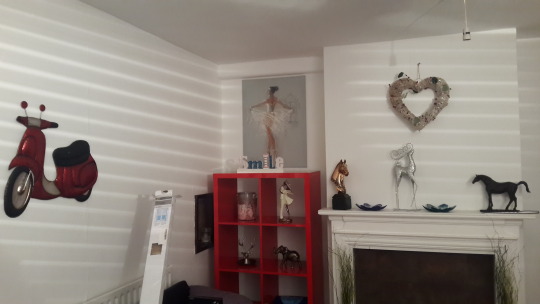
I was quite anxious going in to this location. Seeing as we had no make-up artist, Hannah had to do it herself. Even then, she had to constantly keep running off getting extra ingredients instead of bringing them with her in the first place. This, for some reason, made her feel as though she is not being treated fairly for this.
Patricia was unable to find a location, though she sent me links to several flats, all of them proved to be dead ends. While I managed to get a couple of options secured within 2 hours of searching. Either way, the location proved to be much better than the old one. Though the walls were white as chalk, it had enough ornaments on the walls to make the shots interesting enough. As well as much more space for the cast and crew.
We even managed to get the venetian blind effect done, with the use of the Redhead. Wonderful work by Dmitrij! Alex, the 2nd year student that was kind enough to offer his services as sound recordist, really was a huge asset, not just for the sound but just helping out in general. Dmitrij also had the wonderful suggestion of perhaps including a shot off the statuette in the apartment being splattered with blood. It was a wonderful suggestion, considering the care we would be required to take in order for the shot to work, without splattering the walls.
The shoot went quite well, all things considering. We managed to get the shots required, on time as well as some extra figuring out the blood spurt. I’ve decided to do it on the next day and pick up necessary shots tomorrow, as replicating the pattern of the blood would be nearly impossible without making it seem cheap.
There was quite a moment of tension between me and Sam while we were trying to get the gimbal shot but we managed to resolve it and move on.
However, it is during this time that Hannah approached me about the money required to may our cast. I pointed out that we should have a 100 pounds remaining from the gofundme yet she claimed we spent it on this location, even though I paid for it out of my personal money. She did not have an answer then. She later approached me to say she accidently spent it on her rent and Patricia’s film. I could not confront her over this during the shoot. I had to travel to university to make a copy of the files and once I’ve returned everyone had gone to bed.
0 notes
Text
‘The Second Draw’ Shoot Day 10: Cafe Re-shoot

I was fortunate to find a cafe nearby university that would be willing to allow us to film for 6 hours. Unlike in the previous location, here we had an entire area sanctioned off for us so continuity concerns in terms of patrons in the background was eliminated. We were forced to delay the shoot for an hour however since it turned out nobody had an sd card for the audio. Considering all the people that were not able to make it, Hannah was forced to function as producer, 1st AD and sound recordist, with me having to be on clapper duty.
Despite the problem of the intensity of the background noise, when the amount of patrons fluctuated during the shoot. However, we managed to bypass by recording a wildtrack.
Dean was a great pleasure to work with and he gave a wonderful performance overall, I think.
We then proceeded to move the shoot to university, for the pick up shots for the office and then move on to a missing close-up in the alleyway.
Hannah hadn’t received a response from room bookings but we were hoping to find a room regardless, since its often vacant in that particular part of university.
Unfortunately, all the rooms were occupied. But we eventually managed to get the necessary shots, once a similar one freed up.
We couldn’t get the shot in the alleyway since we didn’t want to have to make our cast and crew wait for another 2 hours in order for it to be dark enough.
So we just figured we might find a similar location near the apartment.
0 notes